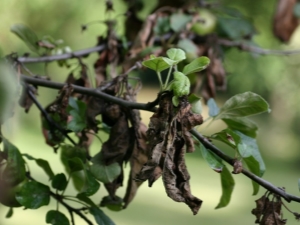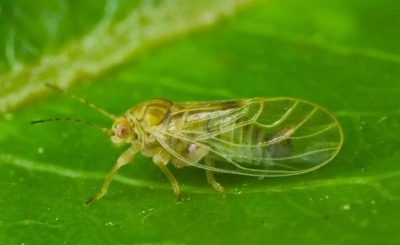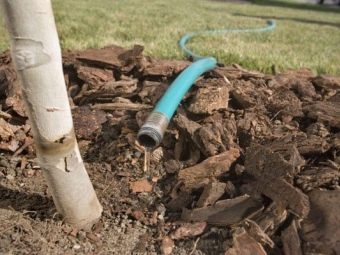Why do the leaves on the pear turn black?

It is very unpleasant for every gardener to see signs of disease or pest damage on a fruit tree.Unfortunately, fruit crops are a tasty and desirable food for parasites. Diseases and insects not only spoil the appearance of the crown, they significantly weaken the whole plant and, in the absence of adequate measures, may even destroy the fruit tree. The article will discuss the causes of blackening of foliage on a pear, as well as ways to eliminate it.
The reasons
No doubt, such external manifestations as twisting, drying, blackening of the leaves and unsightly fruits clearly indicate problems. To help the pear tree to cope with the scourge, it is necessary to identify the source of trouble. But it is not always easy, because there are not so many possible reasons. And on the accuracy of determining the problem will depend on the choice of the correct treatment and care culture.
Diseases
Often the leaves turn black on a pear due to a disease of the fruit tree. Dark or black spots on the leaf plates are a visible sign of the development of fungal microorganisms or viruses. Therefore, to accurately determine the causes of pear disease, you need to familiarize yourself with other signs of the most common ailments of this culture.
Scab is a fungal infection. It often affects fruit trees, their leaves, fruits, and branches. The fungus also likes to settle on young shoots, as they are very gentle and vulnerable to attacks of microorganisms.
At first foliage or fruits infect fungus spores. This is manifested in the appearance of bright green spots. They are not much different from the color of the leaf or immature still green fruit. Therefore, often gardeners and gardeners do not immediately pay attention to them.
With the further development of this fungal disease on the leaf plates appear rounded spots of dark brown and black. They gradually grow and become more visible to the eye. After a short period of time, the leaves dry up and curl up, then fall off.
In summer, the most active scab is in June and July. During this period, you should especially carefully examine the crowns of adult trees and seedlings. Young fragile foliage is usually affected first.
The scab can quickly spread to neighboring trees, especially when planted closely. The source of fungal infection is most often the contaminated soil, last year's untidy foliage, the fruit of diseased trees.
Another very common disease of pears is a black fungus. The microorganism feeds and multiplies on sugary secretions that leave aphids, suckers or thrips.
It can be said that these insects and the fungal microorganism work in a kind of tandem. Therefore, to effectively combat the disease, it is necessary to pay attention to the destruction of the above-mentioned pests.
At the infected leaves, at first not very noticeable dark spots appear. Their number is actively growing. Point darkening expands and turns into very noticeable spots. Gradually blackening captures the entire leaf or fruit of the pear. Outwardly, it looks like the foliage and fruits are covered with a touch of charcoal soot. This plaque is easily removed mechanically if you rub a leaf or a pear. But the removal of soot stains does not lead to a cure.
Moniliasis is a disease better known as fruit rot. The disease develops on the fruits of apple and pear trees. Infected leaves and fruits are first covered with small brown spots. Over time, the entire leaf plate or pear fruit is covered with a dense dark bloom. The pulp of the infected fruit is not affected, but due to the disease it becomes almost tasteless, loose in structure, unsuitable for consumption.
Fruit rot can develop on the branches of fruit trees. Over time, the development of the disease leads to their drying out and brittleness.
A serious disease of pear trees that is poorly treatable is a bacterial burn. At the initial stage of the disease, the edges and tips of the leaves turn black and dry.If there are fruits on the tree, then blackness also appears at their ends. Fabrics of leaves and fruits begin to die off quickly. The tree loses buds, ovaries, actively sheds foliage. Often the plant eventually dies.
Treatment of a bacterial burn is not effective in all cases. The fact is that this disease penetrates the tree sap flow system and very quickly spreads through all plant tissues.
Young pears under the age of 10 years are most often affected by a bacterial infection. Their immune system is still very vulnerable, but at the same time, they have more active internal metabolic processes. These two factors and make them victims of the disease.
Pests
Another reason for the weakened and unhealthy state of pear trees can be insect parasites. The peak of their activity occurs in the summer, so the traces of their vital activity are immediately visible to the eye as the leaves, young shoots and fruits.
Aphids are a real disaster for the garden. Insect is very voracious and causes great damage to fruit trees. This parasite is already activated from early spring, at this time it feeds on the kidneys and tender young leaves.
Symptoms of aphids are immediately noticeable. The leaves on the trees curl into a tube, their edges dry and darken. Insect especially likes to feast on developing young shoots. It is there that one can find the greatest concentration of individuals.
Aphids coexist in tandem with ants. They feed on sugary secretions of the pest and often carry the larvae or adult aphids on themselves. So starting a fight with aphids, you should also get rid of anthills near fruit crops.
Medianitsa significantly harm pear trees. This is a small flying insect that can quickly and easily move around crowns. The pest prefers to feast on young shoots, shoots and succulent leaves.
Exhausted leaves eventually dry up and fall off. The larvae of the pest in the development period produce the so-called "copper dew". She is visible to the eye as a dark bloom on foliage, buds or fruits.
Another pest that infects pears is the insect moth. She settles on the leaves and tightens their edges, forming around her something like a natural cocoon. Eating juice, the leafworm begins to actively lay eggs. The larvae hatched from them also eat foliage in the future.
When attacking this parasite, the leaves are first folded, and after a while they turn black and fall off. Due to the fact that the foliage does not change color immediately, the first signs of defeat by these harmful insects do not immediately catch the eye. It is especially difficult to see folded, but not yet changed color leaflets on high and thick crowns.
Gall mite winters in the buds of the pear tree. With the arrival of warm spring days the insect actively lays eggs. The emerged larvae and adults settle on the blossoming foliage and begin to feed on its juices.
At first, very bright greenish spots appear on the leaves. During this period, inexperienced gardeners may not notice the warning signs and miss the time. Then pimples and turrets (galls) are formed on the leaf plates, in which the tick colonies live. Neoplasms turn brown and black. Insects migrate from galls to new sites, leaving a blackened and desiccated leaf. Externally at this stage, the defeat of the gall mite can be confused with the attack of scab.
The pest can be carried by animals, birds, wind. Often the source of insect in the garden are new seedlings, already affected by the parasite.
Care errors
There are cases when blackening of foliage on a pear is a result of neglecting the rules of agricultural engineering. In other words, improper care of the fruit crop can provoke a change in the color of the foliage.
Black leaves may indicate that the pear lacks moisture in the atmosphere.In this way, the tree reacts to extreme heat and prolonged dry weather. Also, the foliage of the pear does not tolerate the accumulation of dust. In addition to additional watering, in this case it is worth taking care of spraying the crown with water.
Another reason for the darkening of the foliage may be the lack of nutrients. Especially painful pear reacts to a lack of calcium. With its lack of sheet plates begin to darken from the middle to the top of the sheet. The situation is corrected by adding calcium nitrate with irrigation.
If simultaneously with the appearance of darkened leaves, deformation of young shoots is observed. This is a sign of a lack of boron. In this case, the plants should be sprayed with a weak solution of boric acid from the pharmacy.
Treatment methods
Now it is necessary to proceed to the description of specific methods that will help cure diseases and fight pests.
In many cases, you will have to work with chemicals, so you need to remember the safety rules. Take care to prevent contact of the solutions and preparations with open skin. The respiratory tract must be protected by a respirator or at least a thick gauze bandage.
To deal with the insidious and common disease of fruit crops - scab, you need a complex. Affected leaves and fruits should be removed from the tree as soon as possible and burned or removed far from the site. In the autumn you need to carefully collect the fallen leaves, not leaving it for the winter under a pear. Means of control and prevention are also regular thinning of the crown and digging the soil before winter.
In the spring, the pear is sprayed with Bordeaux liquid or karbofos. If during the summer, the signs of the disease reappear, use the drugs "Horus" and "Topaz."
In most cases, treatment will have to be carried out throughout the season until complete disposal of the fungus.
The fight against black fungus should go hand in hand with the destruction of the insects provoking its appearance - aphids and hedgehogs. The fight against these and other pests will be discussed further in the article.
It is possible to treat fungal plaque itself with fungicidal compositions, for example, with the “Skor” preparation. A more environmentally friendly method is the use of products containing microorganisms hostile to the black fungus, rather than chemical poisons. These include compositions "EM 1", "Shining". The microbes contained in these preparations do not harm the pear tree, but actively absorb sugary aphids and suckers. The black fungus at the same time loses nutrition and stops its development on the foliage and fruits.
Methods for getting rid of a disease such as monilioz (fruit rot) are in many ways similar to the above measures to combat scab. In early spring, the crown should be treated with Bordeaux liquid. During the growing season it is advisable to use the drugs "Topsin", "Fitosporin", "Folicur".
The most difficult to treat and insidious pear disease is the so-called bacterial burn. Its course is often quite rapid, and in many cases leads to the rapid death of even an adult tree. The shortness and small percentage of the cure are related to the specificity of this disease. With a bacterial burn, harmful microorganisms penetrate into the tree sap flow system and act from the inside. Therefore, almost all systems and parts of a plant are simultaneously affected and weakened.
In the quality of prevention and strengthening of the protective forces of the fruit crop in the spring, the crown is sprayed with preparations containing copper. Processing can be repeated several times during the summer season.
All parts of the plant that show signs of disease damage should be removed. When cutting branches or sawing knots should be captured and part of the healthy area adjacent to the infected. All cut branches, knots and fruits are utilized or burned.
Treatment is to spray pears with antibiotics. The most commonly used drug is a broad-spectrum "Ofloxacin".
The introduction of antibiotic solutions directly into the stem is an innovative method for curing fruit crops from such diseases. Thus, the antibiotic will fall directly into the composition of the tree sap. In this case, the antimicrobial drug is able to destroy a much larger number of viruses and bacteria walking along the sap flow of the plant.
However, it is not without regret that it is worth noting that not in all cases the measures described lead to a successful healing of the pear tree.
Get rid of the invasion of aphids have throughout the season. Usually the insect reappears on the foliage after precipitation. Often ants bring the larvae of this pest to the trunks and young shoots of fruit trees.
If the defeat of aphids is not too extensive, you can try more sparing folk methods. The most common and well-proven is spraying crown infusion of garlic with the addition of soap. Also common are the methods of exterminating aphids: treating the crown with a solution of furnace ash (300 g of ash boil for 30-40 minutes in 10 liters of water), and ammonia (2-3 tbsp of pharmacy ammonia alcohol) per tin of water, wormwood, tops of tomatoes or tobacco (1 kg of tops of any of the listed plants, pour a bucket of water warmed to 38-40 degrees, leave for at least 3 hours, drain).
In all these means for spraying you need to add liquid soap or dissolve household shavings. The soap solution is better retained on the leaves, does not evaporate for a long time. In addition, a soapy liquid envelops the bodies of aphids and its larvae, depriving them of the ability to breathe through their pores.
Spraying is repeated after 8-10 days or after the last rain.
It is necessary to destroy the suckling from the period of bud break. The branches and barrel are sprayed with kerosene solution. It includes 40-50 g of household soap shavings, 80 g of kerosene. The components dissolve in 10 liters of water. The composition allows you to destroy a significant percentage of overwintered insects.
After blooming of the young leaves, the solution is treated with a solution of carphobia (concentration 0.2%). The same tool is processed in early September, after removal of the fruit.
As in the fight against aphids, traditional methods are very effective: treating the crown with an infusion of ash or tobacco leaves.
The little sheet will have to be exterminated by insecticides ("Fitoverm", "Fusanon"). Spraying is repeated with a break of 2-3 weeks. For the prevention of the spread of the pest in early spring, saplings and crown of adult trees can be treated with "Flyoverm".
So-called acaricides are used to fight against gall mite colonies. The foliage of the affected fruit tree is sprayed for at least two months every two weeks.
From popular recipes, you can use decoction of marigolds (boil 100 g of the plant in a liter of water, cool, add liquid or laundry soap), dandelions, potato tops (prepared in the same way) as auxiliary means.
Prevention
Any disease is better to prevent than to cure. The same principle is quite fair and relevant to fruit crops. The following preventive measures will help prevent the spread of pests and diseases:
- annual pruning of branches with the aim of thinning the crown;
- compliance with agricultural technology;
- ensuring adequate watering and spraying the foliage with water in dry weather;
- carrying out full feeding of plants in the spring;
- cleaning of the stump zone from weeds, fallen leaves and fruits;
- annual autumn soil digging under the crown of the tree;
- timely treatment of diseases and control of pests detected on the pear;
- grafts for vaccination should not be taken from infected plants;
- do not purchase seedlings with signs of illness or pests.
Weakened by insect attacks and diseases, the tree is worse resisted by the above factors, leading to blackening of the leaves.
Useful tips
At the end of the article, it is useful to provide tips and recommendations from experienced gardeners. They will allow you to complement the basic methods of combating diseases and insect parasites:
- After pruning, experienced gardeners are not lazy to sanitize all used tools. The working surfaces of the pruner or scissors are rubbed with alcohol or they are calcined on fire.
- Spraying of plants should be carried out in the evening, after the heat subsides, in dry, windless weather.
- Well strengthens the immune system of the tree and stimulates its growing season regular loosening of the soil in the stalk zone. It is especially important to systematically carry out such a procedure in the first years of the life of young seedlings.
- The trunk of mature trees must be cleaned of dead bark. Pest insects love to nest and lay eggs between its drying parts. And decaying areas serve as a breeding ground for harmful microflora and fungus.
- Preventing the spread of many diseases and pests is whitewashing the trunks of fruit trees.
About why the leaves on the pear turn black, the causes and methods of treatment are shown in the next video.














































